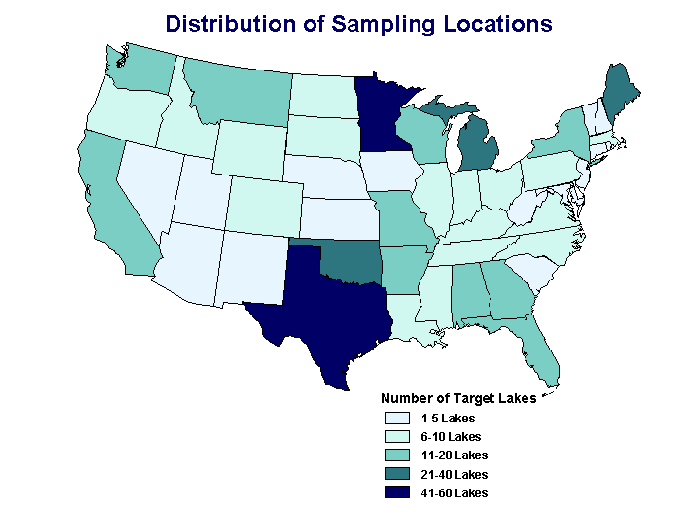National Study of Chemical Residues in Lake Fish Tissue - Basic Information
The U.S. Environmental Protection Agency conducted a national freshwater fish contamination survey to estimate the national distribution of selected persistent, bioaccumulative and toxic (PBT) chemical residues in fish tissue from lakes and reservoirs in the lower 48 states. This four-year study provided the first national estimates of median concentrations for 268 chemicals in lake fish, defined a national fish contamination baseline to track progress of pollution control activities, and identified areas where contaminant levels are high enough to warrant further investigation.
On this page:
Background
Monitoring fish for chemical contamination in lakes and reservoirs is a critical activity for protecting human health because these areas are important for sport fishing and other recreational activities. The 2008 Biennial National Listing of Fish Advisories reports that 43% of the nation’s lake acres are under fish consumption advisories.
Lakes and reservoirs occur in a variety of landscapes and can receive contaminants from several sources, including direct discharges into the water, air deposition, and agricultural or urban runoff. Lakes were the focus of this study because they are environments where contamination accumulates and is more readily detectable.
The EPA initiated the National Study of Chemical Residues in Lake Fish Tissue (or National Lake Fish Tissue Study) in 1998 as a priority activity under the Agency’s Persistent, Bioaccumulative and Toxic (PBT) Chemical Program. It supports the PBT Program and other Agency programs by providing data for a large set of chemicals in fish that could affect the health of people and wildlife that eat fish from these environments.
Why is this Study Important?
The National Lake Fish Tissue Study:
- Generated data to develop the first statistically-based national estimates of the median concentrations of persistent, bioaccumulative and toxic chemicals in lake fish.
- Provided a national baseline for tracking reductions of persistent, bioaccumulative, and toxic chemicals in freshwater fish as a result of pollution control activities.
What are the Basic Elements of the Study Design?
The EPA worked with partner agencies over a four-year period (2000-2003) to collect fish from 500 lakes and reservoirs selected randomly from the estimated 147,000 target lakes and reservoirs in the lower 48 states. The lakes were divided into 6 size categories, ranging in size from 2.5 to over 900,000 surface acres, with a similar number of lakes in each category. Before sampling, field teams verified that each lake is a permanent body of water with a depth of at least one meter and a permanent population of target fish species.
Sampling teams applied consistent methods nationwide to collect composites of one predator species (e.g., bass or trout) and one bottom-dwelling species (e.g., catfish or carp) at each lake. Composites consisted of 5 adult fish of similar size that were large enough to provide 560 grams (20 ounces) of tissue for analysis of fillets for predators and whole bodies for bottom dwellers. Laboratories contracted by the EPA analyzed each composite for 268 chemicals (including PCB congeners).

What Chemicals did the EPA Select for the Study?
The study involved analyzing the fish tissue for:
- 2 metals (mercury and 5 forms of arsenic)
- 17 dioxins and furans
- 159 PCB congener measurements (representing results for 209 congeners)
- 46 pesticides
- 40 other semivolatile organics (e.g., phenols)
Who Participated in the Study?
The EPA formed a national network of study partners to pursue a broad range of activities, from development of the study design to collection of fish for the study. Important contributors include:
- EPA Office of Water (Agency lead for the study)
- EPA Office of Research and Development
- EPA Office of Prevention, Pesticides, and Toxic Substances
- EPA Regional Offices
- State and Tribal Agencies
- National Park Service and Tennessee Valley Authority
What are the Key Study Accomplishments?
The study consists of four phases:
Planning (1998-1999)
- study design development
- random lake selection
- target chemical selection
Mobilization (1999-2000)
- orientation workshops
- development of partnerships
- production of quality assurance and
field sampling plans - lake reconnaissance
Sampling and Tissue Analysis (2000-2005)
- sampling of 500 lakes
- chemical analysis of fish samples and QA review of the data
- database development
Data Analysis and Reporting (2006-2009)
- statistical analysis of fish tissue data
- publication of two journal articles
- production and release of the final report (PDF)
